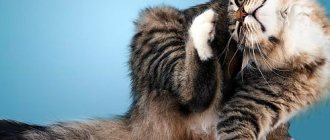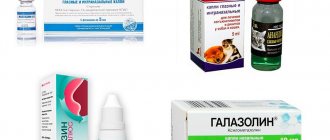A cat's vaginal discharge is the result of a natural physiological process. The secreted mucus lubricates the walls of the internal genital organs and protects them from infections. In the presence of pathology, the color, smell, quantity and consistency of the lubricant change, which allows timely detection of the problem before it worsens.
Types of discharge in cats
The most informative indicator is the color of the cat’s vaginal discharge. With its help, even the owner can make a presumptive diagnosis.
White
White discharge in a cat, accompanied by an unpleasant odor, is a consequence of an abscess, that is, suppuration. Most often it occurs against a background of weakened immunity after infection with protozoa and bacteria.
Pink or bloody
Bloody discharge in a cat varies in its abundance. Small droplets or whole clots may flow out of the loop. This symptom indicates damage to the blood vessels.
Purulent
Purulent discharge in a cat is always accompanied by an unpleasant odor. As the inflammatory process worsens, the clear liquid gradually thickens, acquiring a white tint. Over time, the pus becomes creamy, yellow, greenish, or brown. Darkening of the shade indicates necrotic processes in the mucous membranes.
After mating
Bloody discharge from the loop may appear in a cat after mating in the event of resorption of the fetus, which can occur at any stage of pregnancy. In most cases, the animal’s body independently copes with the problem , expelling the dead fetuses from the womb, but they can also remain in the uterus for quite a long time.
As a result, fruit rot begins, which can lead to inflammation of the cat’s genitals and blood poisoning. Resorption of the fruit is accompanied by bleeding with pus and mucus. Blood clots have a rather pungent odor.
A possible cause of bleeding after mating can also be an ectopic pregnancy. In this case, urgent assistance from a veterinarian is necessary—delayed surgical intervention can lead to the death of the pet.
Non-dangerous causes of the problem
Non-dangerous reasons include physiological ones, that is, those associated with the characteristics of the body. Most often, mucous fluid appears during estrus, pregnancy and after childbirth.
Pregnancy and childbirth
By the 3rd week after mating, the cat begins to have a clear discharge with thick mucus. They are difficult to notice because they are excreted in the urine. The secreted mucus is excess plug that clogs the cervix. During pregnancy, it protects the fetus from infections.
Closer to 6 weeks, excess amniotic fluid comes out of the loop. It has a transparent or yellowish tint.
At 9 weeks the plug is rejected. Having noticed the appearance of a yellowish or greenish clot, you can begin preparing for childbirth. With the onset of contractions, the cat begins to have bloody discharge.
After the kittens are born, mucus may be released from the loop for another 3 weeks. No need to worry about this. Your cat's reddish discharge will gradually turn brown and disappear. Greenish inclusions are also acceptable these days.
Estrus
Unlike dogs, cats should not bleed during heat. The mucus emerging from the loop should be transparent and uniform in consistency. The presence of an unpleasant odor is unacceptable.
The duration of estrus is from 3 to 7 days. At this time, the pet becomes very excited and affectionate. She sleeps poorly at night, constantly meows and arches her back, moving her tail to the side when you press on her sacrum. The onset of estrus can only be noticed by behavioral changes, as the animal is constantly licking itself.
Discharge after pregnancy
The presence of bloody discharge in a pregnant cat is completely normal when it is presented as transparent, homogeneous, odorless clots.
However, prolonged discharge of purulent-bloody discharge with a greenish tint after birth indicates possible inflammation of the animal’s genital organs.
It often happens that the fetus gets stuck in the cat's womb, or the placenta for some reason does not come out of the uterus, as a result of which the process of rotting begins. In both cases, surgical removal of the foreign object will be required, because prolonged decomposition inside the animal's body can lead to intoxication of the pet.
Sometimes bloody discharge during the postpartum period may be just remnants of the placenta. Usually the placenta is completely expelled from the uterus within 3 hours after birth, and the number of membranes should correspond to the number of kittens. In this case, surgical intervention is not required.
Possible pathologies
Most pathological causes are associated with inflammation and infection of the uterus. This can lead to infertility and even death. To avoid complications, it is necessary to diagnose the existing disease as soon as possible and begin its treatment.
Pyometra
The risk group includes unsterilized animals over 5 years old. Due to hormonal imbalance, pus accumulates in the uterus, so the cat develops copious brownish or cream-colored discharge. Spots of the corresponding color can be seen on the bedding and other resting places of the pet.
The most dangerous form of pyometra is closed. With this disease, the pus does not extend beyond the uterus. This is accompanied by acute pain and enlargement of the abdomen. Over time, the walls of the organ cannot withstand and become damaged. The contents spill into the abdominal cavity, causing the death of the animal.
Endometritis
If a cat's white discharge appeared shortly after birth, then placenta particles could remain in the uterus. Their rotting can provoke endometritis - inflammation of the uterine mucosa. In addition to delayed placenta, the disease can occur due to hormonal imbalance and infection of the genital organs.
The appearance of abundant mucopurulent exudate is accompanied by frequent urination, loss of milk and severe pain. An advanced form of endometritis is fraught with the development of pyometra, infertility and sepsis.
Hematometer
Scanty bleeding in a cat, accompanied by fever and cramping pain, is characteristic of hematometra. With this pathology, blood accumulates in the uterus, since it cannot pass through the endocervix (mucous membrane of the cervix). Narrowing or blockage of the cervical canal occurs due to:
- muscle spasm;
- abortion or miscarriage;
- uterine fibroids;
- congenital anomalies;
- incorrectly performed operations;
- frequent childbirth.
Accumulating blood attracts pathogenic microorganisms. Over time, this leads to purulent inflammation - pyometra.
Hydrometer
With a hydrometer, secretions produced by the uterine glands, transudate and exudate, accumulate in the uterus. If the cervical canal is open or only partially blocked, a small amount of white or clear fluid will leak from the loop. This pathology is most easily detected in a sterilized cat whose discharge is not typical.
Hydrometra is often a complication of the chronic form of endometritis. Over time, the walls of the uterus stretch and become thinner. Scarring and adhesions appear at the site of ruptures. Without timely assistance, death occurs.
Vaginitis
With vaginitis, the walls of the vagina become inflamed and covered with ulcers. The catarrhal-purulent form of the pathology is complicated by an abscess. A sick cat develops a viscous white discharge that resembles thick cream.
The main causes of the disease are a sharp decrease in immunity and postpartum vaginal trauma. Opportunistic bacteria (Escherichia coli, streptococci, staphylococci) living in the body are activated and cause infection.
Other diseases
In addition to the listed diseases, bleeding, copious mucus and pus can be a symptom of several other pathologies. These include:
- Malignant tumors
. Blood appears not only in mucus, but also in urine and feces. As the condition worsens, pus is released. Oncology often occurs due to hormonal imbalances caused by taking drugs to suppress desire.
- Bleeding disorder
. Hematological pathology is accompanied by the appearance of scarlet liquid or clots.
- Vaginal phlegmon
. Inflammation affects the subcutaneous fat of the vulva. Due to the gradual growth of the organ, abscesses appear. The pus coming out of the vulva has a mucous consistency.
- Uterine trauma
. The appearance of scarlet blood shortly after sterilization is a complication caused by careless surgical intervention. In this case, it is better to call a veterinarian at home, since transporting the animal can aggravate its condition.
- Placental abruption or decomposition
. When placental abruption occurs, brown clots appear from the loop. If the kittens die in the womb, the color changes to green. Decomposition adds a strong, unpleasant odor. Bleeding may also occur. If these symptoms occur, you must urgently contact a doctor to prevent the death of the animal.
To identify a possible cause, it is necessary to take into account all accompanying symptoms. If the pet is active, eats well and takes care of the kittens, then you don’t have to worry about her.
Diagnosis and treatment
If vaginitis is suspected, the cat is examined, the medical history is taken into account, and the veterinarian prescribes a urine test, blood test, ultrasound, and colposcopy. Conduct a rapid test for brucellosis. The form of the disease is established - serous, catarrhal-purulent, diphtheritic or phlegmonous. Pyometra and tumors are excluded.
If serous or purulent-catarrhal vaginitis is diagnosed, douching is prescribed. The following antiseptics are used:
- Chlorhexidine;
- Iodinol;
- Furacilin;
- chamomile decoction.
For diphtheritic or phlegmonous forms of vaginitis, it is practiced to insert tampons soaked in antimicrobial oil emulsions into the vagina. In severe cases, antibiotics are prescribed - Stomorgyl or Sinulox.
Abscesses and phlegmons are opened. If vaginitis occurs in a kitten, no treatment will be required. Pathological symptoms will disappear during the first heat. For estrogen deficiency that occurs in castrated cats, or ovarian hypofunction, hormonal drugs are used.
Prevention consists of proper nutrition, which maintains the immune system at the proper level. It is necessary to avoid accidental matings and mate females with proven males.
Associated symptoms
Be sure to contact your veterinarian if the condition of your mustachioed pet causes you concern. Dangerous symptoms accompanying these pathologies include:
- extreme thirst, poor appetite and weight loss;
- excessive licking or biting of the perineum, as well as rolling on the floor on the butt;
- breathing problems and rapid heartbeat;
- vomiting, diarrhea, or constipation;
- deterioration in the appearance of fur;
- increased frequency and reduction of urination, as well as plaintive meowing every time you go to the toilet;
- lethargy, apathy or aggression;
- temperature increase;
- excessive attraction of cats in the absence of heat;
- rounding of the abdomen not associated with pregnancy.
If you find at least one of the listed signs, get diagnosed. The sooner treatment is started, the greater the chances of a quick recovery without complications.
Types of disease
According to the nature of the inflammatory process, serous, catarrhal-purulent, diphtheritic, and phlegmonous vaginitis are distinguished.
Based on the causes of occurrence, the following types of vaginal inflammation are classified:
- Primary - occurs as a result of mechanical damage during lambing or mating, as well as low concentrations of estrogen after castration or at a young age, before the gonads begin to function.
- Secondary - is a symptom of infectious diseases, primarily brucellosis, as well as sexually transmitted infections due to accidental mating or mating with an infected cat.
According to the speed of appearance of clinical signs, acute and chronic vaginitis are distinguished.
What should the owner do?
If physiological reasons are not suitable, and the pet’s condition does not return to normal, trust the veterinarian. Self-medication in such a situation can only aggravate the existing problem.
Diagnostics
The symptoms of many diseases are the same, so before starting treatment it is necessary to establish the exact cause of the ailment. In addition to examination and history taking, the following results will be required to make a diagnosis:
- general and biochemical blood test;
- Ultrasound of the abdominal cavity;
- vaginoscopy;
- x-ray;
- a smear or scraping from the vagina;
- bacterial sowing;
- biopsies.
The number of studies will depend on the condition of the animal. The list presented may be expanded or shortened.
Treatment
Depending on the diagnosis, drug or surgical treatment is used. Mild forms of infection, vaginitis and pyometra are treated with antibiotics and douching.
A more radical method of therapy is castration, that is, the complete removal of all reproductive organs. The operation is mandatory if there is a threat to life (malignant tumor, closed pyometra). Also, surgical intervention is necessary to correct the consequences of poor-quality sterilization and removal of placenta fragments.
What to do if there is blood in the discharge
The appearance of blood in the discharge indicates a violation of the integrity of the mucous membranes. The next stages most often are infection, formation of pus and filling of the problem organ with it. In the absence of help, tissue ruptures and sepsis develops. There is a high probability of death, so with this symptom you need to take the animal to the veterinarian as quickly as possible.
It is not recommended to do anything on your own: blood can appear for several reasons. Due to self-medication, at best you will waste time, at worst you will aggravate the animal’s condition.











